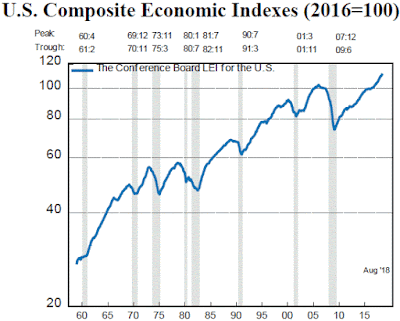Consumer Sentiment: Final Result for September 2018
Predicted: 100.8
Actual: 100.1
- Change from Previous Month: +4.054% (+3.9 points)
- Change from 12 Months Previous: +5.258% (+5.0 points)
=========
Previous Month's Final ICS Reading: 96.2
=========
From today's report:
"...Consumer sentiment remained at very favorable levels in September, with the Index topping 100.0 for only the third time since January 2004. Most of the September gain was among households with incomes in the bottom third, whose index value of 96.3 was the highest since November 2000. In contrast, the Sentiment Index among households with incomes in the top third lost a total of 8.1% during the past seven months since reaching its cyclical peak of 111.9 in February 2018. This divergence across income subgroups has been observed in past economic cycles and indicates that the expansion has now benefitted nearly all population subgroups.
All households held very optimistic expectations for improved personal finances in the year ahead, the most favorable financial prospects since 2004 (see the chart [BELOW]). Despite a lessening in September of the expected size of gains in nominal incomes, inflation expectations also declined, acting to offset concerns about declining living standards. Consumers anticipated continued growth in the economy and expected the unemployment rate to continue to slowly decline during the year ahead. The single issue that was cited as having a potential negative impact on the economy was tariffs. Concerns about the negative impact of tariffs were cited by nearly one-third of all consumers in September.
Those [who] voiced negative views of tariffs also held much less favorable prospects for the economy and held inflation expectations that were 0.6 of a percentage point higher than those who didn't mention tariffs. The pace of growth in real personal consumption expenditures can be expected to average 2.6% during late 2018 and into the first half of 2019..."
=========
 |
| Consumer Sentiment - Expected Change In Household Finances Chart - September 2018 |
The ICS is derived from the following five survey questions:
- "We are interested in how people are getting along financially these days. Would you say that you (and your family living there) are better off or worse off financially than you were a year ago?"
- "Now looking ahead, do you think that a year from now you (and your family living there) will be better off financially, or worse off, or just about the same as now?"
- "Now turning to business conditions in the country as a whole, do you think that during the next twelve months we'll have good times financially, or bad times, or what?"
- "Looking ahead, which would you say is more likely: that in the country as a whole we'll have continuous good times during the next five years or so, or that we will have periods of widespread unemployment or depression, or what?"
- "About the big things people buy for their homes, such as furniture, a refrigerator, stove, television, and things like that. Generally speaking, do you think now is a good or bad time for people to buy major household items?"
- Click here for more on how the ICS is calculated.
=========
The ICS uses a 1966 baseline, i.e. for 1966, the ICS = 100. So any number that is below the 1966 baseline of 100 means that the folks who were polled recently aren't as optimistic about the U.S. economy as the sample that was polled back in 1966.
The ICS is similar to the Consumer Confidence Index in that they both measure consumer attitudes and offer valuable insight into consumer spending.
=========
The "predicted" figure is what economists were expecting, while the "actual" is the true or real figure.
=========
Labels: consumer_sentiment, consumers, soft_data
|
--> www.FedPrimeRate.com Privacy Policy <--
> SITEMAP < |









